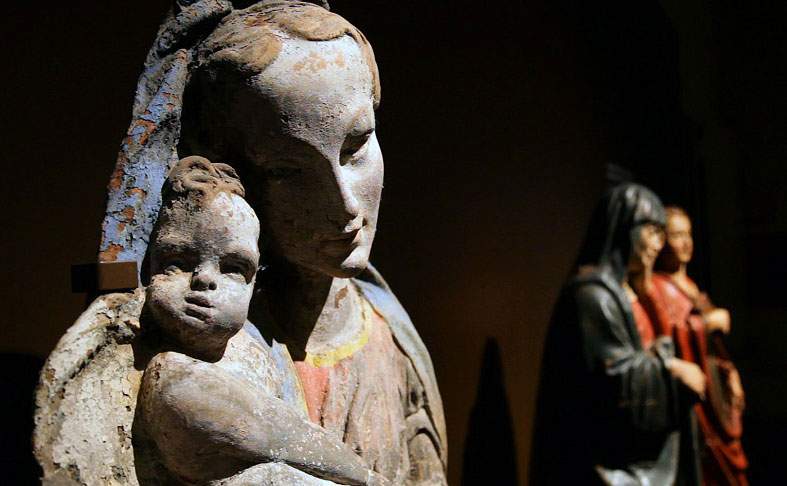Placed in the new Schifanoia Museum the Madonna and Child who escaped two earthquakes
The new Schifanoia Museum in Ferrara also houses the Madonna and Child, among the most fascinating works of 15th-century Ferrara, which has already escaped two earthquakes, the one in 1570 and the one in 2012, and the lighter tremors of March 2020.
The story of the work deserves to be told and known: exposed for decades to the elements on the second floor of an apartment building in Via Saraceno 9, it can now be seen by the public in the sixth room of the museum building.
“It is a fascinating story with a happy ending, the result of the intuition of citizens who grasped its value, confirmed by historical insights,” said Ferrara Mayor Alan Fabbri. “Schifanoia today welcomes the outcome of the happy and fruitful collaboration between private and public in the name of heritage protection and the common good. To all goes my thanks.”
“When, in January 2020, we mounted the scaffolding to restore the gutters and facade of the apartment building on Via Saraceno,” says Paul Terzolo, of the company that carried out the work, “we saw this work up close. The excitement was great: I assumed, as an art enthusiast, that it was a valuable sculpture, exposed to the elements and in a precarious condition. So I informed Valentino Nizzo,” now director of the National Etruscan Museum of Villa Giulia in Rome, but with a Ferrara past, since until 2015 at the Soprintendenza and the National Archaeological Museum. “I also mentioned it at a condominium meeting,” Terzolo continues, “and everyone showed great sensitivity. On that occasion I also found out that a condominium owner, who now lives in the Netherlands, had bought the apartment on Via Saraceno precisely because she was struck by that work.”
“When I saw the first photos I immediately tried to investigate further and found only a text that generically attributed it to the 17th century,” says Valentino Nizzo. “This did not convince me completely. In fact, the work seemed to show the peculiarities typical of the late 15th century, with the overcoming of the medieval canon and the first reception of the stimuli of the Renaissance. The answer could therefore lie in Professor Vittorio Sgarbi’s volume on Domenico di Paris and the sculpture of the 15th century in Ferrara, a point of reference to allow the work’s framing to be confirmed.”
Given the sculpture’s precarious situation (it was threatening to fall at any moment) and considering its dire conservation conditions, the Soprintendenza Archeologia, Belle Arti e Paesaggio authorized its urgent detachment. The Terzolo family and condominiums immediately took action: “We ’boxed’ it in full lockdown by creating a special box, made of wood stuffed with foam rubber, and to bring it to the ground we had to dismantle two rows of scaffolding. Then we stored it in a safe place, in agreement with the Superintendence.”
“Given the value of the work,” recounts Soprintendenza official Donatella Fratini, “after securing it, the ’Declaration of Cultural Interest’ followed; a process that was happily concluded with notification to the owners in September 2020. This is a demonstration that the Superintendencies do not just drop the articles of the Cultural Heritage Code on the heads of citizens, but strive daily to make people understand the meaning and sense of their action.”
The continuation of the story was recounted at the opening of the Schifanoia Museum: the Museums of Ancient Art, in anticipation of the refurbishment of the Museum in Via Scandiana, offered, through the Museums of Ancient Art Manager Giovanni Sassu, temporary residence to the sculpture because the work “very well known to scholars, although still anonymous, is one of the most relevant testimonies of the expressiveness of Este figurative culture.”
“The story of this work,” concludes Councillor Gulinelli, “is fascinating and demonstrates, once again, the extraordinary widespread artistic value present in Ferrara but, above all, it shows what teamwork and collaboration mean. I would like to thank the condominiums and the Terzolo family for their commitment and sensitivity, Dr. Nizzo for his support, Dr. Fratini for her decisive active role, and Dr. Sassu for choosing the best location for this Madonna and Child, which was a happy surprise for everyone. The new Schifanoia Museum has a strong identity soul and welcomes the historical and artistic contribution that has crossed Ferrara in at least three centuries, starting from the 15th century. It is a value for the city and the country, as Minister Franceschini also stressed during his visit last Saturday.”
Pictured is the Madonna and Child on display in the new Schifanoia Museum in Ferrara.
 |
| Placed in the new Schifanoia Museum the Madonna and Child who escaped two earthquakes |
Warning: the translation into English of the original Italian article was created using automatic tools. We undertake to review all articles, but we do not guarantee the total absence of inaccuracies in the translation due to the program. You can find the original by clicking on the ITA button. If you find any mistake,please contact us.



























